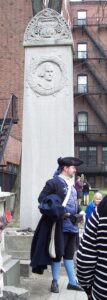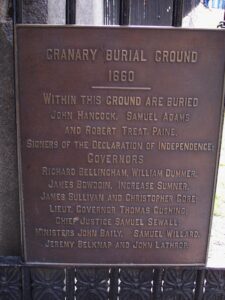
John Hancock monument, Granary Burying Ground, Boston, MA (2009 photo by Karen)
This is an interesting tombstone inscription. It is a rebus puzzle, a word picture puzzle. The word rebus is derived from Latin phrase non verbis, sed rebus, meaning “not by words, but by things.”
Can you figure out this rebus?
A hint: this monument is located in the Granary Burying Ground in Boston and is the marker for one of the signers of the Declaration of Independence.
It is the monument for John Hancock. The hand and the chickens/cocks make up the name Hancock. Clever. Below the rebus are the Latin words obsta principiis, “contrary to principles.”
John Hancock was born in Braintree, Norfolk County, Massachusetts in 1736 and died in Quincy, Norfolk County, Massachusetts in 1793. His Hancock family was in Massachusetts as early as 1638. John Hancock married Dolly Quincy in 1775 and they had two children who did not live to adulthood.
John Hancock’s father, a minister, died when John was young and John was raised by his uncle. John Hancock graduated from Harvard in 1754 and inherited his uncle’s merchant business in 1764. In 1768, his merchant ship Liberty was seized by customs officials and Hancock became a vocal critic of British policy.

John Hancock monument, Granary Burying Ground, Boston, MA (2009 photo by Karen)
John Hancock was elected to the Massachusetts Legislature in 1769 and attended the First Continental Congress in 1774 and the Second Continental Congress following year. He was elected to serve as President of both Continental Congresses and as their president he was the first person to sign the Declaration of Independence. Hancock’s signature on the Declaration of Independence was so bold that to this day, signing your name is referred to as signing your “John Hancock.”
On 19 April 1775 the British Army marched out of Boston to Lexington, in part to capture John Hancock and fellow-patriot Samuel Adams, but Paul Revere’s ride warned them to flee. In 1778 Hancock led 5,000 Massachusetts soldiers in an unsuccessful attempt to free Rhode Island from the British.
In 1780 John Hancock became President of the Massachusetts Convention and became the first Governor under their new charter. He was very popular in Massachusetts and served nine terms as governor, from 1780-1785 and from 1787 until his death in 1793.

John Hancock monument, Granary Burying Ground, Boston, MA (2009 photo by Karen)
The Granary Burying Ground was founded in 1660 and is Boston’s third oldest cemetery. Also buried there are Paul Revere, three signers of the Declaration of Independence: Samuel Adams, Robert Treat Paine, John Hancock, and five victims of the Boston Massacre.

John Hancock monument, Granary Burying Ground, Boston, MA (2009 photo by Karen)

John Hancock monument, Granary Burying Ground, Boston, MA (2009 photo by Karen)
We visited the Granary Burying Ground in 2009.


